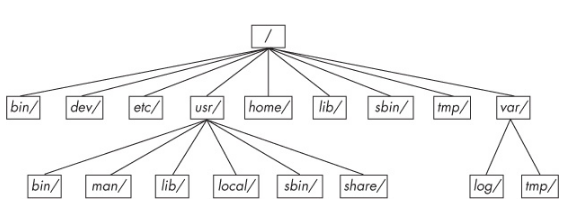All the summaries are from the book named How Linux Works.
Let’s check the directory hierarchy of linux first.

This picture offers a simplified overview of the hierarchy, showing some of the directories under /, /usr, and /var. Notice that the directory structure under /usr contains some of the same directory names as /.
Here are the most important subdirectories in root:
/binContains ready-to-run programs(also known as an executables), including most of the basic Unix commnads such aslsandcp. Most of the programs in/binare in binary format, having been created been by a C compiler, but some are shell scripts in modern systems./devContains device files./etcThis core system configuration directory contains the user password, boot, device, networking, and other setup files. Many items in/etcare specific to the machine’s hardware. For example, the/etc/X11directory contains graphics card and window system configurations./homeHolds personal directories for regular users. Most Unix installations conform to this standard./libAn abbreviation for library, this directory holds library files containing code that executables can use. There are two types of libraries: static and shared. The/libdirectory should contain only shared libraries, but other lib directories, such as/usr/lib, contain both varieties as well as other auxiliary files./procProvides system statistics through a browsable directory-and-file interface. Much of the/procsubdirectory structure on Linux is unique, but many other Unix variants have similar features. The/procdirectory contains information about currently running processes as well as some kernel parameters./sysThis directory is similar to/procin that it provides a device and system interface./sbinThe place for system executables. Programs in/sbindirectories relate to system management, so regular users usually do not have/sbincomponents in their command paths. Many of the utilities found here will not work if you’re not running them as root./tmpA storage area for smaller, temporary files that you don’t care much about. Any user may read to and write from/tmp, but the user may not have permission to access another user’s files there. Many programs use this directory as a workspace. If something is extremely important, don’t put it in/tmpbecause most distributions clear/tmpwhen then machine boots and some even remove its old files periodically. Also don’t let/tmpfill up with garbage because its space is usually shared with something critical./usrAlthough pronounced “user”, this subdirectory has no user files. Instead, it contains a large directory hierarchy, including the bulk of the Linux system. Many of the directory names in/usrare the same as those in the root directory(like/usr/binand/usr/lib), and they hold the same type of files./varThe variable subdirectory, where programs record runtime information. System logging, user tracking, caches, and other files that system programs create and manage are here.
Other Root Subdirectories
There are a few other interesting subdirectories in the root directory:
/bootContains kernel boot loader files. These files pertain only to the very first stage of Linux startup procedure;/mediaA base attachment point for removable media such as flash drives that is found in many distributions./optThis may contain additional third-party software. Many systems don’t use/opt
The /usr Directory
The /usr directory may look relatively clean at first glance, but a quick look at /usr/bin and /usr/lib reveals that there’s a lot here; /usr is where most of the user-space programs and data reside. In addition to /usr/bin, /usr/sbin, and /usr/lib, /usr contains the following:
/includeHolds header files used by C compiler./infoContains GNU info manuals./localIs where administrators can install their own software. Its structure should look like that of/and/usr./manContains manual pages./shareContains files that should work on other kinds of Unix machines with no loss of functionality. In the past, networks of machines would share this directory, but a true/sharedirectory is becoming rare because there are no space issues on modern disk. Maintaining a/sharedirectory is often just a pain. In any case,/man,/info, and some other subdirectories are often found here.
Kernel Location
On Linux system, the kernel is normally in /vmlinuz or /boot/vmlinuz. A boot loader loads this file into memory and sets it in motion when the system boots.
Once the boot loader runs and sets the kernel in motion, the main kernel file is no longer used by the running system. However, you’ll find many modules that the kernel can load and unload on demand during the course of normal system operation. Called loadable kernel modules, they are located under /lib/modules.